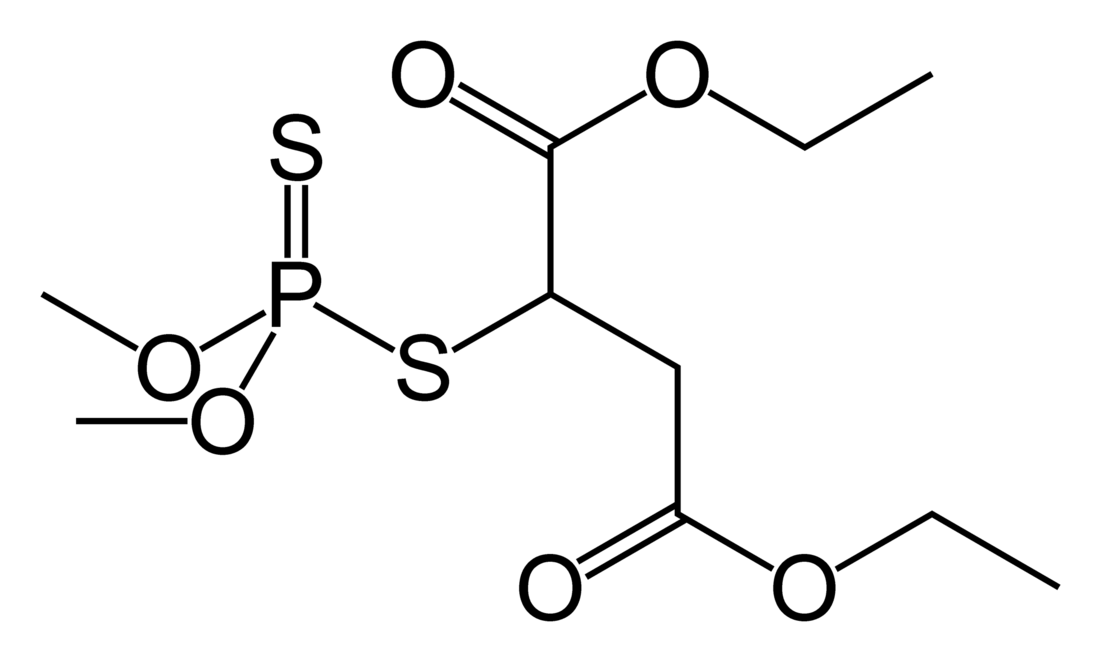Top Qs
Timeline
Chat
Perspective
Malathion
Chemical compound From Wikipedia, the free encyclopedia
Remove ads
Malathion is an organophosphate insecticide which acts as an acetylcholinesterase inhibitor. In the USSR, it was known as carbophos, in New Zealand and Australia as maldison and in South Africa as mercaptothion.
Remove ads
Pesticide use
Malathion is a pesticide that is widely used in agriculture, residential landscaping, public recreation areas, and in public health pest control programs such as mosquito eradication.[6] In the US, it is the most commonly used organophosphate insecticide.[7]
A malathion mixture with corn syrup was used in the 1980s in Australia to combat the Mediterranean fruit fly.[8] In Canada and the US starting in the early 2000s, malathion was sprayed in many cities to combat west Nile virus.[9]
In the United Kingdom, malathion was withdrawn from sale in 2002.[10]
Remove ads
Mechanism of action
Malathion is an acetylcholinesterase inhibitor, a diverse family of chemicals. Upon uptake into the target organism, it binds irreversibly to the serine residue in the active catalytic site of the cholinesterase enzyme. The resultant phosphoester group is strongly bound to the cholinesterase, and irreversibly deactivates the enzyme which leads to rapid build-up of acetylcholine at the synapse.[11]
Remove ads
Production method
Malathion is produced by the addition of dimethyl dithiophosphoric acid to diethyl maleate or diethyl fumarate in the presence of catalytic amounts of triethylamine and hydroquinone at elevated temperature:
- (CH3O)2PS2H + C8H12O4 → C10H19O6PS2
This process produces the S enantiomer.[12]
Medical use
Malathion in low doses (0.5% preparations) is used as a treatment for head lice and body lice infection (pediculosis) in the US, where it is approved by the US Food and Drug Administration.[13][14] In some areas in the UK, head lice had developed a resistance to malathion as of 1999[update], and it was ineffective against 64% of cases. This is believed to be caused by development in the lice of an enzyme-mediated malathion specific esterase, able to destroy malathion bound to the acetylcholine receptor.[15]
It is also used for the treatment of scabies.[16][page needed]
Preparations include Derbac-M, Prioderm, Quellada-M and Ovide.[17][18]
Remove ads
Risks
Summarize
Perspective
General
Malathion is of low toxicity. It metabolizes to the more toxic malaoxon in many species.
In arthropods it is metabolized into malaoxon which is 61x more toxic, being a more potent inhibitor of acetylcholinesterase.[4] In studies of the effects of long-term exposure to oral ingestion of malaoxon in rats, malaoxon has been shown to be 61 times more toxic than malathion, and malaoxon is 1,000 times more potent than malathion in terms of its acetylcholinesterase inhibition.[19][20]
Absorption or ingestion into the human body also readily results in its metabolism to malaoxon, which is substantially more toxic.[19] It is cleared from the body quickly, in three to five days.[medical citation needed] According to the United States Environmental Protection Agency, no reliable information is available on adverse health effects of chronic exposure.[21]
In 1981, Malathion was sprayed over a 1,400 sq mi (3,600 km2) area to control an outbreak of Mediterranean fruit flies in California. In order to demonstrate the chemical's safety, B. T. Collins, director of the California Conservation Corps, publicly swallowed a mouthful of dilute malathion solution.[22]
Carcinogenicity
Malathion is classified by the IARC as probable carcinogen (group 2A). Malathion is classified by US EPA as having "suggestive evidence of carcinogenicity".[4] This classification was based on the occurrence of liver tumors at excessive doses in mice and female rats and the presence of rare oral and nasal tumors in rats that occurred following exposure to very large doses. Exposure to organophosphates is associated with non-Hodgkin's lymphoma. Malathion used as a fumigant was not associated with increased cancer risk. Between 1993 and 1997, as part of the Agricultural Health Study, no clear association between malathion exposure and cancer was reported.[23]
Toxicity to Amphibians
Malathion is toxic to leopard frog tadpoles.[24]
Remove ads
Regulation
Different organizations and governments have set different drinking water quality standards for malathion.
The World Health Organization has determined that while malathion can last in water for months and years, it usually does not last in water for longer than one to two weeks; and since the amount of malathion found in drinking water is usually lower than a level that would lead to concerns about health that there is no need to set a drinking water guideline for the level of malathion allowed in water.[25]
In contrast, the Canadian government has set a maximum acceptable concentration of 0.29 mg/L of malathion in drinking water, and requires that drinking water should be monitored for the chemical when there is a reason to suspect it is in the water and might need to be removed.[26]
Australia has a much lower maximum level of 0.07 mg/L of malathion in drinking water.[27]
The European Union has set their level still lower at 0.10 μg/L for any one pesticide in drinking water, including malathion.[28]
The United States does not have an official maximum contaminant level for malathion, but proposes a lifetime health advisory of 0.5 mg/L.[29]
Remove ads
See also
References
External links
Wikiwand - on
Seamless Wikipedia browsing. On steroids.
Remove ads





